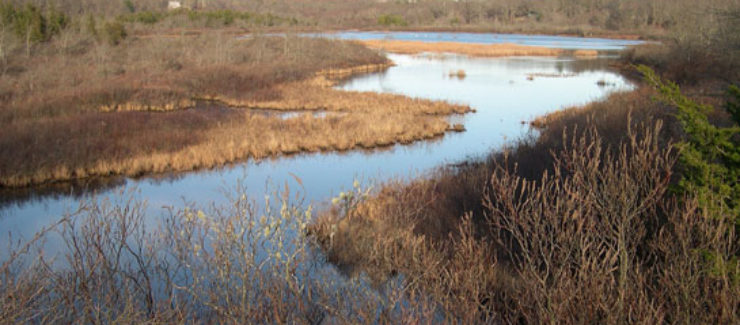Slopes And Wetland Buffer Legislation Leading To More Development In Charlestown
The following letter was submitted to local newspapers and is reprinted here with permission of the author Ruth Platner. Ruth is the current Chair of the Charlestown Planning Commission.
In 2013 and 2016, the Rhode Island Legislature passed bills that allow unbuildable perimeter wetlands and steeply sloped land to be included when sizes of buildable lots are determined. The bills included language for slopes or wetland buffers saying that those areas “shall not be excluded from the calculation of the buildable lot area or the minimum lot size, or in the calculation of the number of buildable lots or units.”
These bills were opposed by Charlestown’s legislators, Representative Blake Filippi and Senator Elaine Morgan, because these bills removed local control over planning, zoning, and the protection of Charlestown’s environment. These bills were also opposed by Charlestown’s Town Council, the Town Councils of many other rural towns, and a multitude of statewide environmental groups, all of whom argued that, when land containing wetlands was subdivided and if the buffers to those wetlands were then considered in the buildable area, more house lots would be created; that the houses on lots containing large wetland buffers would need to be built very close to the buffers; and that this would negatively impact the wetlands if the buffers were disturbed. Despite this opposition, the bills passed with the sponsor of these bills citing his “clients” need for the legislation. Yes he said “clients” not constituents!
This legislation took effect in 2016, and since 2016, subdivision applications have come before the Charlestown Planning Commission that contain lots that make up large percentages of their buildable area with steep slopes and perimeter wetlands. Lots that have large areas of wetland buffer understandably are limited regarding where houses can actually be built, and this creates conflicts with wetland protection.
Perimeter wetlands are very important for wetland wildlife, but the buffers are usually dry and are not easily recognized by homeowners. Despite being protected by state regulation, these wetland buffers are often cleared, graded, or filled unknowingly by homeowners. The Rhode Island Department of Environmental Management (RIDEM) can fine homeowners and require that they restore these wetland buffers, but RIDEM doesn’t go door to door checking in people’s backyards. Unless complaints are made, RIDEM generally has no knowledge of these violations.
Since the state legislation changed, the Charlestown Planning Commission has required developers to mark the wetland buffers on the ground before selling lots, but it is unknown if the markers are left in place or even understood by new homeowners.
The Planning Commission is currently reviewing applications from several different developers to create 50 new lots by subdividing land with large areas of wetlands.
Also before the Planning Commission are 20 residential condominium units, over 400 self-storage units in two different proposals, and other commercial proposals, some of which are in Groundwater Protection Districts or contain wetland buffers.

You can learn more about the author, Ruth Platner, at her profile page.

April 27, 2021 @ 9:07 am
I have to conclude that in the case of “water” of any kind ( i.e. Drinking ,wetlands , buffers to wetlands) the towns know better what is a danger to their water than do any State Legislators.
Charlestown has well drinking water, and several salt water ponds AND fresh water ponds feeding into our drinking water. It behooves our town council, our realtors and especially our planning commission to decide on actions which they deem detrimental to our WATER……that is any kind of WATER.
Thank you to town staff, commissions and councilors who are working on this for our town of Charlestown!
April 25, 2021 @ 3:43 pm
I question the accuracy and applicability of using developers to mark the wetlands buffers. I have seen where the wetland buffers were marked in the center of small drainage streams. There must be a better way. Maybe the use of advanced collection techniques can identify the true wetlands buffers. Rather than relying on people who have much to gain from the determination of the buffers, maybe a small set of independent wetlands engineers could be used. Besides, I believe that currently there are questionable practices in not only determining the wetland buffer areas but also in transmitting and utilizing that information.
April 27, 2021 @ 7:04 am
We do require that applicants apply to RIDEM for wetlands edge verification. A biologist from DEM will make a field visit and check the location of the wetland flags and request changes in their position if they disagree with the applicant’s placement.
April 25, 2021 @ 10:57 am
Its interesting that the town can’t enforce it’s own environmental restrictions that are “more protective” than state provisions. Its my understanding that on a federal vs. state level that is indeed the case. For example if the federal clean water act sets a dissolved oxygen standard of 5 ppm, the state could set their standard at 6 ppm. What stops the town from being more restrictive or requiring greater protection than state law? Unfortunate.
April 25, 2021 @ 11:11 am
The majority in the Rhode Island Legislature have been chipping away at local control in the last decade. In the past, towns were allowed to have stronger environmental regulations than the state. The state regulations were considered the minimum. That has reversed in more recent years with state regulation replacing local control, especially for wetland protection. Many in the legislature are sympathetic to development interests.
April 27, 2021 @ 2:14 pm
I agree that the town should be able to have and enforce stronger protections. Development decisions are and should be local community decisions. The feds and state can have their laws and so long as there isn’t a conflict they can exist happily together. Just because the state law allows further encroachment into wetlands and buffer zones doesn’t mean the town must approve the development. The area of the summer winds proposal is a wetland and buffer zone. It’s so close to ninigret and the there are several ponds there. Water should be a big concern as well as sewage. The proposed development and access roads run through pristine habitats. Several old red maples and many other rare native plants etc. in addition the proximity to ninigret and conservation land the wildlife refuge and town park this is an area that should only see a very scaled down development if any. The town should not approve this proposal.